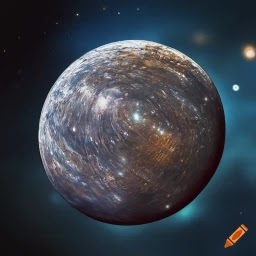Certainly! Mercury is the smallest and closest planet to the Sun in our solar system. Here are some key details about Mercury:
Size and Composition:
- Mercury has a diameter of approximately 4,880 kilometers (3,032 miles), making it the smallest planet in our solar system.
- It is a rocky planet, composed mainly of rock and metal. It has a large iron-nickel core, accounting for a significant portion of its mass.
Orbit and Rotation:
- Mercury has an eccentric orbit, meaning it is more elliptical than circular. It takes about 88 Earth days to complete one orbit around the Sun.
- Despite its slow orbit, Mercury has a rapid rotation. It completes one rotation on its axis about every 59 Earth days. This 3:2 resonance between its rotation and orbit means that it experiences three "days" for every two "years."
Surface Features:
- Mercury's surface is heavily cratered and resembles the Moon. It has plains, ridges, and cliffs, and some areas show evidence of volcanic activity in the past.
- The Caloris Basin is one of the largest impact basins on Mercury, created by a massive asteroid or comet impact.
Temperature Extremes:
- Mercury experiences extreme temperature variations due to its lack of a substantial atmosphere to retain heat. Daytime temperatures can soar up to around 430 degrees Celsius (800 degrees Fahrenheit), while nighttime temperatures can plummet to about -180 degrees Celsius (-290 degrees Fahrenheit).
Thin Atmosphere:
- Mercury has a very thin and tenuous atmosphere, known as an exosphere. It consists mainly of trace amounts of hydrogen, helium, oxygen, sodium, and potassium. The low gravity of the planet contributes to the difficulty of retaining a substantial atmosphere.
No Moons:
- Mercury does not have any natural moons or satellites.
Exploration:
- The Mariner 10 mission (1974–1975) was the first spacecraft to visit Mercury, capturing images of about 45% of its surface.
- The MESSENGER (MErcury Surface, Space ENvironment, GEochemistry, and Ranging) mission, launched in 2004, provided more detailed observations and data about Mercury. MESSENGER orbited Mercury from 2011 to 2015.
Future Missions:
- BepiColombo, a joint mission between the European Space Agency (ESA) and the Japan Aerospace Exploration Agency (JAXA), was launched in 2018 to further study Mercury. It is expected to arrive at Mercury in the 2020s.
Mercury's proximity to the Sun and its unique characteristics make it an interesting subject of study for scientists and astronomers.



تعليقات
إرسال تعليق